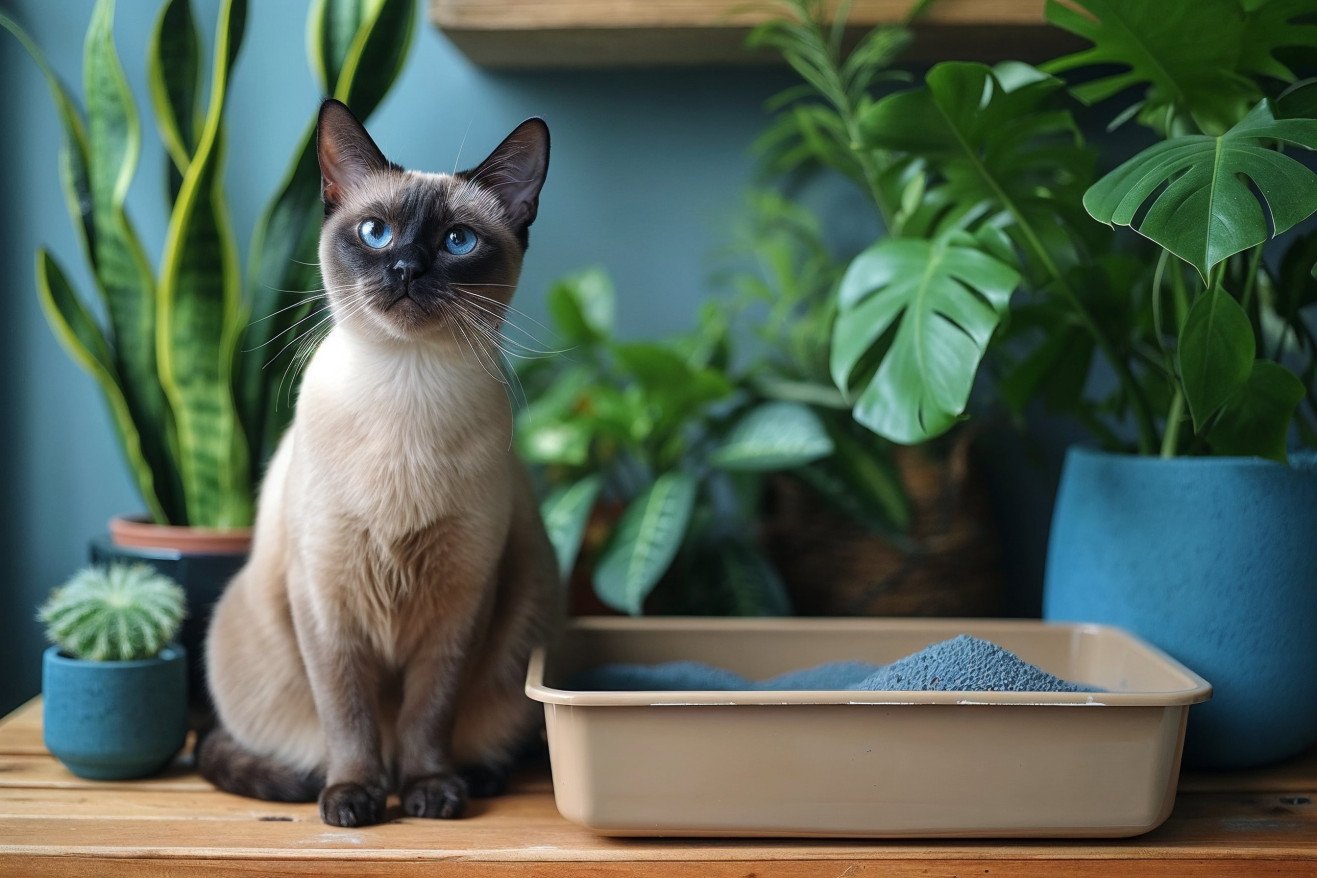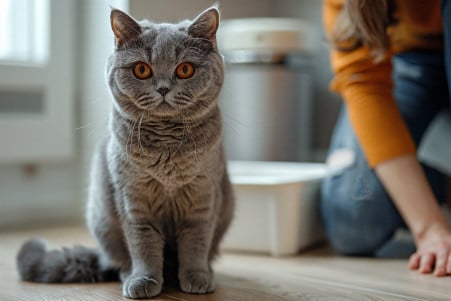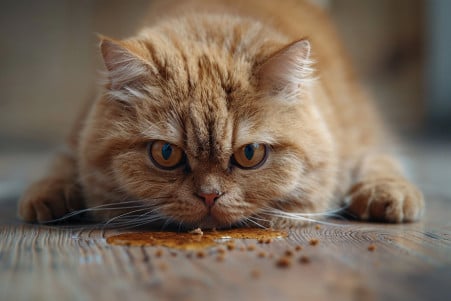Cat Behavior Modification: What to Do Instead of Punishing Litter Box Problems
5 February 2024 • Updated 6 February 2024

If you have a cat that’s having litter box issues, you know how frustrating it can be. But is punishment the answer? According to experts, you should never punish your cat for pooping outside the litter box. Instead, you should try to get to the bottom of the problem by looking at potential health issues, the cleanliness of the litter box, and other stressors.
Working with a vet and making sure your cat’s litter box is a place they want to go are the first steps in making sure this doesn’t happen again.
In our in-depth look at cat behavior modification, we’ll cover everything from veterinary science to animal behaviorism to feline psychology. We’ll talk about why punishment is not recommended and instead focus on what cats need and the environmental factors that can impact their litter box use.
This research will help us build out humane and successful strategies for encouraging good litter box behavior, which will ultimately lead to a better, healthier relationship between cat owners and their feline friends.
What are effective methods to deal with a cat's inappropriate elimination?
Understanding Litter Box Behavior in Cats
Cats are known for their love of routine, and their litter box habits are no exception. Their instinctual need for cleanliness and their desire to mark their territory both play a role in how they use the litter box.
That said, there are many reasons why a cat might stop using the litter box. According to PetMD, medical issues like gastrointestinal problems, arthritis, diabetes, kidney disease, cognitive dysfunction, and even matted fur can lead to a cat avoiding the litter box.
It’s important to pay attention to your cat’s litter box habits, as they can be an important clue that something is wrong.
That said, there are also many behavioral and environmental reasons why a cat might stop using the litter box. Stress from changes in the home, a dirty litter box, or a litter box that’s in a location the cat doesn’t like can all lead to a cat finding somewhere else to go.
According to the Cornell University College of Veterinary Medicine, a cat may also start to avoid the litter box if they have a negative association with it, like pain from urinary tract inflammation or a dislike of the litter.
Despite what some people think, cats don’t pee and poop outside the litter box to get back at their owners. Punishing a cat for not using the litter box won’t solve the problem and can actually make the bond between a cat and their owner worse.
Instead, it’s important to understand the problem from the cat’s point of view and make sure their needs are being met so that you can live together happily and healthily.
Positive Discipline: How to Correct Your Cat’s Litter Box Issues
Punishment is often the first thing that comes to mind when you’re trying to correct your cat’s litter box issues. However, punishment doesn’t work the same way for cats as it does for humans.
The Humane Society of Missouri cites a statement by the American Veterinary Society of Animal Behavior that warns against using punishment for behavior modification because it often results in unintended consequences, including but not limited to increased fear, anxiety, and even aggressive behaviors.
Punishment can lead to cats feeling stressed and confused instead of learning because they often don’t understand the connection between their actions and the punishment.
In addition, punishment can harm the bond between a cat and its owner. Cats.com explains that cats may associate punishment with their owner instead of their own behavior, leading to a relationship of fear or distrust. This can make behavioral issues worse, and Purina notes that positive reinforcement is more effective than punishment.
If an owner uses positive reinforcement to reward good behavior in their cat, they are more likely to repeat that behavior. For example, if you praise your cat and give them a treat when they use the litter box, they are more likely to continue using it in the future.
As owners work to move away from punishment and toward understanding, it’s important to note that each cat’s behavior is impacted by a number of medical and environmental factors. By considering these factors, owners can find more effective ways to address their cat’s litter box issues.
Factors to Consider in Litter Box Training
If your cat is not using the litter box, it is important to first take them to the vet. According to PetMD, there are many medical conditions, such as gastrointestinal issues, arthritis, diabetes, kidney disease, cognitive dysfunction, and even matted fur that could be causing your cat to avoid the litter box.
By catching these issues early, you can make sure that your cat doesn’t develop a long-term habit of not using the litter box.
The physical setup of the litter box is also important. The Humane Society says that the ideal litter box is in a location that is acceptable and accessible, quiet, and not in a high-traffic area. In multi-cat homes, it is recommended that there are multiple litter boxes to ensure that each cat feels comfortable and to prevent conflicts over the litter box.
Environmental stressors, such as changes in routine or household dynamics, can also cause inappropriate elimination. It is important to take an individualized approach that takes into account a cat’s preferences for the type of litter, the size of the box, and how clean the box is.
If this doesn’t work, it may be necessary to work with an animal behaviorist to get personalized help and create an environment that is conducive to proper litter box use.
Pawsitive Reinforcement: Shaping Good Litter Box Habits
Reward-based training can help shape good litter box habits by offering a positive path. Cat Behavior Associates explains that positive reinforcement is important for improving your relationship with your cat. By giving treats or other rewards when your cat uses the litter box correctly, you can help them learn the behavior you want them to exhibit. This way, your cat will come to expect positive outcomes when they use the litter box.
It’s important to be patient when training your cat as it can take time for behaviors to change. That said, being consistent with your rewards and the schedule you keep can help reinforce the new behavior.
In addition, environmental enrichment can help reduce stress and encourage good litter box habits. By making sure your cat has a stimulating environment that includes toys, scratching posts, and other places to climb, you can help ensure that your cat is less stressed and less likely to exhibit stress-related behaviors.
If you’ve tried everything and your cat still won’t use the litter box, you may want to consider working with a certified animal behavior professional. These professionals can provide personalized advice that takes into account your cat’s specific needs, which can help you and your cat live together more harmoniously. In addition, working with a professional can help you avoid the stress that trial and error during the training process can cause your cat.
How to Promote a Positive Litter Box Experience
If your cat is avoiding the litter box due to stress, you can help by creating a more peaceful environment. A study in the journal PMC found that stress-related factors had a significant impact on feline behavior, so it’s important to make sure your cat feels safe and secure.
This can be done by making sure the litter box is in a good location and is kept clean. Cats are more likely to use the litter box if it’s in a quiet area that’s free from disturbances and if the box is kept clean and free from odors.
Pheromone diffusers release synthetic versions of the chemicals that cats naturally produce to calm themselves, according to Fear Free Happy Homes. These diffusers can help reduce anxiety in cats.
In addition to pheromone diffusers, environmental enrichments, such as cat trees and hiding spots, can also help reduce stress. When introducing new things to your cat’s environment, make sure to do so slowly so that you don’t overwhelm your cat, and make sure to keep a consistent routine.
Diamond Pet recommends interacting with your cat on a regular basis to monitor their comfort level and look for any signs of stress. This consistent, observant approach will help ensure that the environment is always welcoming, which will make it more likely that your cat will use the litter box and will also help set a peaceful tone for your cat’s day.
Take a Holistic View of Litter Box Training
While this article has focused on the problems with punishing a cat for pooping outside the litter box, it’s important to note that a holistic view of the situation that takes into account a cat’s health, environment, and behavior is necessary to come to a compassionate solution.
PetMD points out that everything from gastrointestinal issues to stress can cause a cat to avoid the litter box, so it’s important to see a vet if your cat’s behavior changes suddenly.
A study published in PMC found that a better understanding of cat care and behavior resulted in a stronger human-cat bond and fewer behavioral issues. Meanwhile, the Life with Cerebellar Hypoplasia Cats blog stresses that patience and positive reinforcement are key to helping cats learn new behaviors while still maintaining a strong human-animal bond.
If you’re still having trouble with litter box training, it’s important to work with professionals who can help you come up with a plan that’s tailored to your cat. By focusing on your cat’s needs and taking a compassionate, understanding approach, you can not only solve issues with inappropriate elimination but also improve your and your cat’s overall quality of life.


